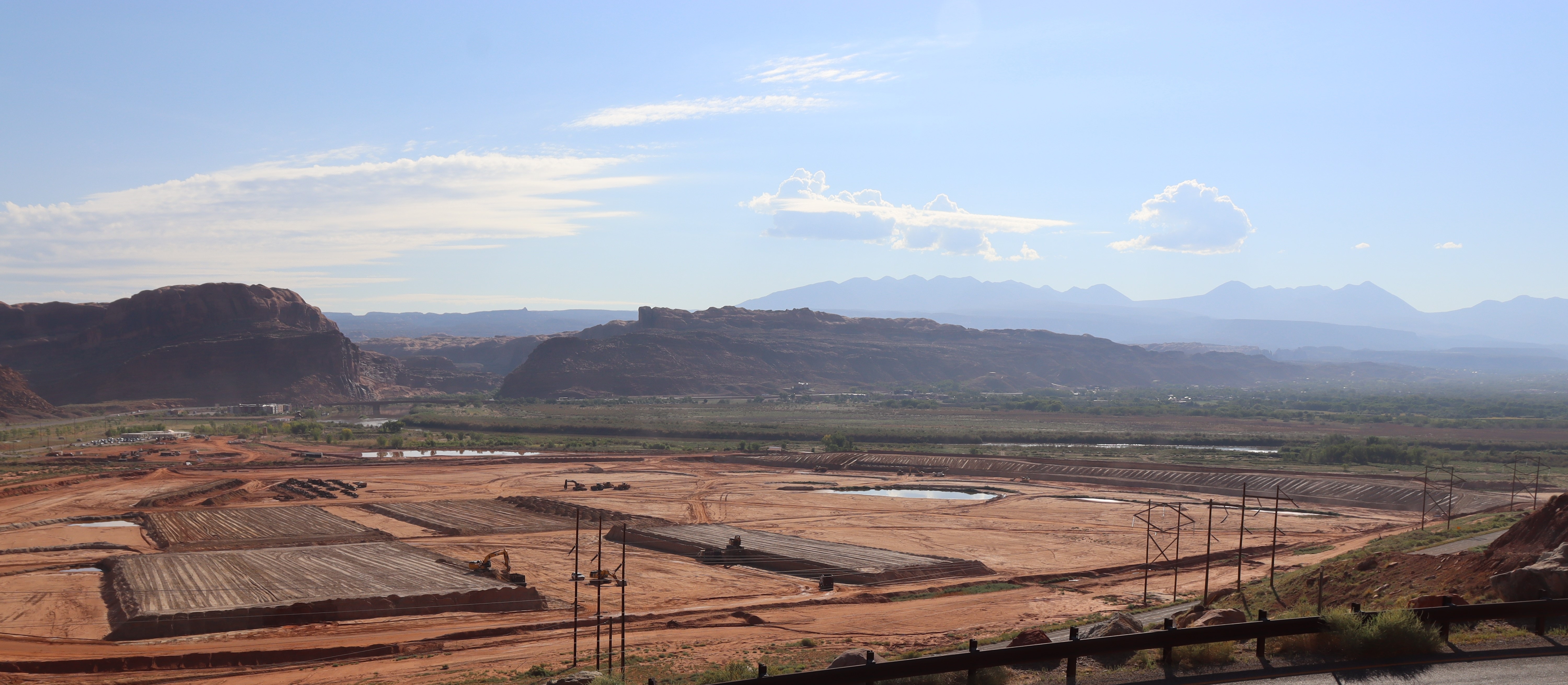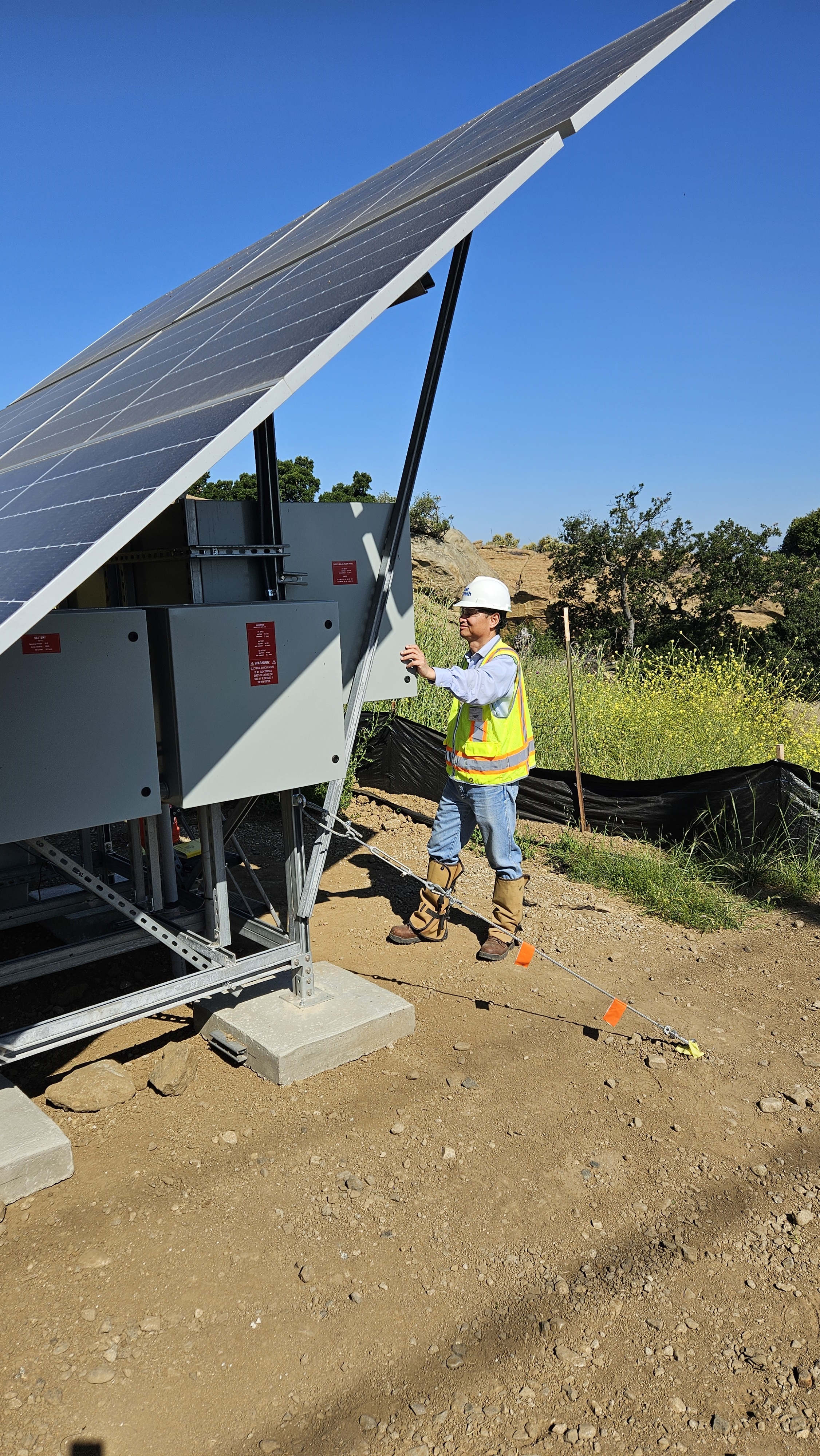Jack Zimmerman, Director, Environmental Management Consolidated Business Center
“Over the past year, the steadfast commitment of EM’s workforce has been evident in their efforts to meet cleanup priorities and milestones while reducing risks to the public and the environment. With a focus on excellence and safety, they successfully tackled complex challenges and made remarkable strides in environmental stewardship, establishing a benchmark for future endeavors.”
HIGHLIGHTS
- The EM Nevada program completed the safe demolition of ancillary structures at the Engine Maintenance, Assembly, and Disassembly and Test Cell C facilities that were part of the historical Nevada National Security Sites Nuclear Rocket Development Station.
- A cumulative 15 million tons of the uranium mill tailings at the Moab site was safely transported to the Crescent Junction disposal site—an EM 2024 priority.
- Removed a program total of more than 54,000 gallons of contaminated groundwater and installed a new automated pump system at the former Sodium Disposal Facility at the Santa Susana Field Laboratory site.
- Completed pre-demolition abatement and hazard removal at Building 251 at Lawrence Livermore National Laboratory—an EM 2024 priority.
- Reached 75 percent completion on the Main Plant Process Building (MPPB) demolition at the West Valley Demonstration Project (WVDP).
- WVDP disposed of a cumulative 20,000 tons of MPPB waste since the start of the demolition project—an EM 2024 priority.
SAFE, COMPLIANT CLEANUP AT THE WEST VALLEY DEMONSTRATION PROJECT
Workers safely shipped more than 40 million pounds of demolition debris from the Main Plant Process Building, the last major facility to be removed at WVDP since starting the project in the fall 2022. For the second year in a row, crews packaged and shipped by rail more than 1,000 waste containers for safe disposal off-site, achieving the annual goal ahead of schedule. West Valley crews safely overpacked and shipped eight high integrity containers; processed, overpacked, and shipped four Chemical Process Cell specialty containers; and overpacked and shipped 12 oversized legacy waste containers to an off-site disposal facility. The team also completed the safe demolition of the former security guardhouse. Built in 1965, it was one of the first facilities constructed at the former commercial nuclear fuel reprocessing facility. Workers also completed the demolition of old locker rooms near the former guardhouse, restored the area and installed new sidewalks. Crews safely collected a liquid sample from an underground tank that once stored liquid waste from spent fuel reprocessing operations to characterize the tank’s content for future disposition and cleanup.
EM NEVADA ACHIEVES GOALS IN DEMOLITION, GROUNDWATER MONITORING, AND WASTE DISPOSAL
The EM Nevada program advanced the demolition of the Engine Maintenance, Assembly, and Disassembly (EMAD) and Test Cell C (TCC) facilities. At EMAD, crews demolished a water tower, an electrical substation, and two stacks. At TCC, crews prepared for the demolition of four liquid hydrogen dewars. Both facilities were part of the now inactive Nuclear Rocket Development Station.
Model evaluation work continued at the Pahute Mesa groundwater region where crews installed remote data transmission equipment at groundwater wells for more efficient data collection.
In addition, EM Nevada supported the safe and secure disposal of more than 760,000 cubic feet of low-level waste, mixed low-level waste, and classified waste at the Radioactive Waste Management Complex.

MOAB MOVES TOWARD COMPLETION AND CLOSURE
The Moab Uranium Mill Tailings Remedial Action Project continues steady progress toward cleanup completion and project closure. Milestone activities completed include the submittal of a revised Remedial Action Plan and final evapotranspiration cover design to the Nuclear Regulatory Commission, advancement of field investigations to support development of the Groundwater Compliance Action Plan, placement of interim cover on a portion of the disposal cell, and finalization of the end-state vision document.
A cumulative 15 million tons of uranium mill tailings—approximately 94 percent of the estimated total of the tailings surface-pile—were transported to the Crescent Junction site disposal cell. Complete relocation of mill tailings is expected by 2027 with transition and closure in 2029.
Left Side Caption: An overlook view of the Moab Site tailings pile, with rectangular drying beds.

ENHANCED GROUNDWATER MEASURES AND COMMUNITY ENGAGEMENT DRIVE ENERGY TECHNOLOGY ENGINEERING CENTER ACTION AHEAD OF EXPECTED CLEANUP MILESTONES
Groundwater interim measures, biological and cultural preservation and ongoing soils planning with the state of California continue to drive the Energy Technology Engineering Center’s (ETEC) cleanup efforts at the Santa Susana Field Laboratory (SSFL).
A new automated pump system was installed at ETEC’s Former Sodium Disposal Facility, removing a program total of over 54,000 gallons of contaminated groundwater from the site. In preparation for public comment periods on final groundwater and soil cleanup plans, EM participated in a Groundwater University workshop series and engaged with stakeholders in the community to share cleanup information and answer questions.
Workers check the solar skid panel and data on the human-machine interface software used for the automated groundwater interim measures project in Area IV at SSFL.
Right Side Photo Caption: Workers check the solar skid panel and data on the human-machine interface software used for the automated groundwater interim measures project in Area IV at SSFL.
LAWRENCE LIVERMORE NATIONAL LABORATORY COMPLETES PRE-DEMOLITION HAZARD REMOVAL AND DEMOLITION ACTIVITIES AT MULTIPLE LOCATIONS
EM’s deactivation and decommissioning activities supports the Lawrence Livermore National Laboratory and paves the way for new facilities at the lab’s one-square-mile footprint.
EM completed demolition and waste removal activities of Building 251 and removed asbestos from the exterior of Building 280.
Two of four high-risk facilities slated for removal will be completed by the end of the year—Building 175 and Building 251.
DEMOLITION MISSION CONTINUES AT BAYVIEW AND THE BUILDING 71 COMPLEX, PAVING WAY FOR NEW FACILITIES AT LAWRENCE BERKLEY NATIONAL LABORATORY
The Lawrence Berkeley National Laboratory project continued EM’s mission to improve health and safety by cleaning up existing contamination and improving seismic standards of buildings within Department laboratory grounds. EM completed the Old Town Demolition Phase VI Project that removed the Building 4 and 14 slabs, underground structures and associated contaminated soil to provide for a buildable site for future mission use, marking the completion of the Old Town demolition projects which started in fiscal year 2012. EM also commenced planning activities for demolition of additional Bayview area excess facilities and the Building 71 complex, setting up EM for demolition scoping and activities in 2025.
CONTINUED EXECUTION OF GROUNDWATER MISSION GETS ONE OF THREE PLUMES CLOSE TO TRANSITION AT SANDIA
The Sandia Environmental Restoration Project continued the characterization and remediation of three plumes of contaminated groundwater at the Sandia National Laboratories section of Kirtland Air Force Base, adjacent to Albuquerque, New Mexico. The primary sources of contamination are elevated nitrates derived from man-made and natural sources. Activities in 2024 included EM acquiring regulatory approval of the Final Remedy as Long-Term Stewardship for the Burn Site Groundwater Area of Concern (AOC). For the Technical Area V AOC, the Corrective Measures Evaluation report was submitted as scheduled on May 30, 2024. In fiscal year 2025, the Tijeras Arroyo Groundwater AOC is expected to begin transitioning back to the National Nuclear Security Administration (NNSA). EM will continue to manage the long-term monitoring requirements until the work is transitioned to NNSA, which is expected to occur by 2031.

